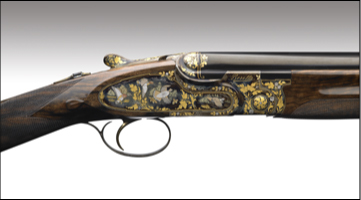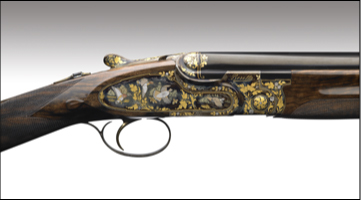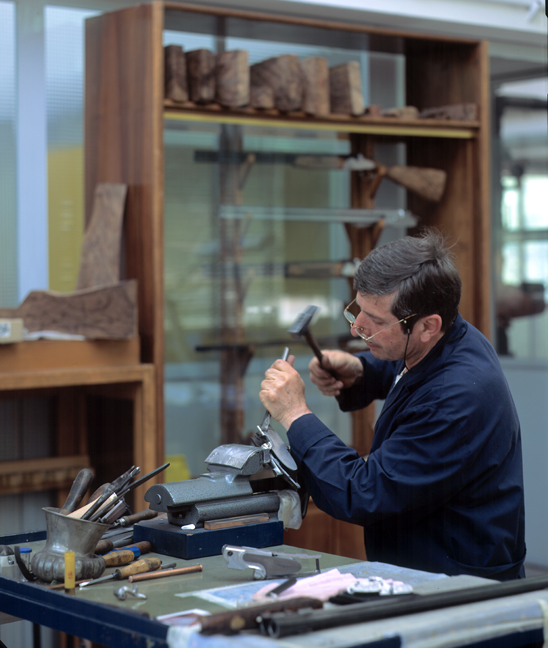An Extraordinary Week With Beretta Traveling Through Half a Millennia

In this first of a three-part series, we arrive at the Beretta headquarters in Italy, where Michael Sabbeth queues up his story about the exceptional SO 10 with a brief company history. See first hand why Franco Beretta told Michael “The SO 10 is the highest expression of the Beretta spirit.”
I arrived at the Beretta headquarters in Gardone Val Trompia at 8:30 in the morning. I waive at the security camera and the heavy metal gate slowly swings open. I entered the grounds and inhaled air that is ionized with history. The majestic snow-capped Guelielmo Mountain overlooked the valley like a guard tower.
The Beretta family invited me to Gardone to write about the evolution of their highest grade over/under shotgun, the SO 10, and their newest iteration of the acclaimed 680 series over/under shotgun, the SV 10 Perennia, which has been the beneficiary of the SO 10’s technology and aesthetics. As a stunning gesture of generosity, Beretta had also arranged for me to visit two of the Beretta wineries, Lo Sparvieri in Franciacorta, and its recently acquired vineyard, Costello di Radda, in Radda in Chianti, Tuscany.
Beretta is the oldest manufacturing company in the world. Officially, Beretta dates its founding or beginnings based on a receipt from the Doges of Venice dated October 3, 1526, written to master Bartolomeo Beretta of Gardone acknowledging payment of 296 ducats for 185 arquebus barrels delivered to the Venice Arsenal. However, although barrels inscribed with the Beretta name have been traced back to before 1500.
Ugo Gussalli Beretta’s automobile was already parked under the arches connecting the office complex with the massive stone structure that was once the Beretta family home. Ugo Gussalli is the fifteenth generation director of the Beretta empire formally known as Fabbrica d’Armi Pietro Beretta. He has been awarded the prestigious honorific, ‘Cavalieri,’ which is the equivalent of knighthood status in recognition of his stellar contribution to business and commerce.
I also noticed Franco Beretta’s blue sports car parked nearby. Franco is the younger of Ugo and Monique Beretta’s two sons. I tend to spend more time with him during my visits than with Pietro, the older son, in large measure because Franco is more intimately involved in the creation and production of the high grade guns, which are the purpose of my visits. I am impressed, yet again. These folks work. They work hard. They are in the office early and, from what I have been able to discern, they stay late.
In 1832 the firm adopted the official name of “Fabbrica d’Armi Pietro Beretta,” which is unchanged to the present day. Under Giuseppe Beretta’s presidency, the re-birth of private enterprise proved to be the principal means of guaranteeing the firm’s prosperity and development.
By 1878, Beretta alone possessed the capability for total arms production, bringing to its premises raw iron and wood and sending out finished guns. In its catalogs and at industrial expositions, Beretta presented itself as the Prima Fabbrica Italiana d’Armi de Caccia, di Lusso e da Difesa, Italy’s First Manufacturer of Hunting, Luxury and Personal Defense Weapons.
The gun trade in the valley has been the source of its vitality. An historical footnote captured eloquently is this quotation from a petition sent in April, 1683, by gun and barrel maker Giovanni Beretta, then mayor of Gardone, April to the Capitano of Brescia:
“At the feet of your Excellency, most worthy representative of the Public Majesty, the craftsmen of Gardone bow down. Born among the mountains, suckled on iron, raised in the smithies, from all of which they draw the sustenance that maintains them, bronzed by the endless heat of the fires, they can earn their living only by laboring with heavy hammers on the anvils. If this work is lacking, then they are deprived of life itself.”
From the Forward of The World of Beretta by R. L. (Larry) Wilson

Franco Beretta, who has earned the title dottore, and who possesses an uncanny ability to infuse a poetic phrase into any discussion, explained that he and his father wanted his family to produce a gun more refined than any ever constructed that embodied what he called a “nuovo estetica nel rispetto della tradizione Beretta,” that is, a new aesthetic with respect for the Beretta tradition.
The SO 10 “would be an enrichment of the past rather than a break with it,” Franco said. “We must continue to work to be original in the aesthetics and the mechanical solutions.” Eyes intense, he added, “We are Beretta. We don’t want to make a copy of other shapes.”
The SO 10 derives from the SO line of high grade over/under shotguns. The first model was built in 1934 and was designated the S 01. Overtime, evidently, according to folks who are supposed to know these things, the ‘0′ became an ‘O’ and the series became knows as the SO guns.
Most significant design features included Boehler steel barrels, monobloc constructions, a recessed curved bottom of the action and a large Greener-style transverse cross bolt. A large top molding transitioned into a heavily sculpted bolster arcing down on each side of the action from the fences and then the steel line fluidly curved into the upper lines of the sculptured sideplates.
The juxtaposition of aggressively angled straight cuts and sinuous curves caused the eyes to move horizontally and vertically, further enhancing the justifiable sense of the action’s mass and solidity. These designs have been deemed unsurpassed in durability and reliability.
The SO 10 departs dramatically from the previous guns in the series, both aesthetically and in design. The official company explanation for introducing the gun in 20 gauge was that the 12 gauge was well represented by the SO 6 and SO 9 models. Franco explained the true reason for the gauge selection: “From an aesthetic point of view,” he said, “the real hunter prefers the 20 gauge for its superb weight and balance. Everything is a matter of proportion. That is why we chose to introduce the gun in that gauge.”
The grupo de lavore, the team workers, drafted to create this new gun was led by Carlo Ferlito, Director of Product Development, Manufacturing and Marketing. The two master gun makers assigned the task of creating and crafting the SO 10 were Bortolo Gitti and Claudio Fioretti. They had been employed previously at Franchi, which Beretta acquired around 1998. Between them they have almost seven decades of experience. They are men with sparkling eyes, great wit and an unqualified love for building the finest guns in the world. So closely are they identified with each other that they have been nicknamed “The Blues Brothers.”

Beretta master engraver Bartolo Gitti at the bench.
I mention the most dramatic of the SO 10’s design features. Departing from the semi-circular action bottom and the transverse bolt, the SO 10 features a Boss-styled bolting system with bites on the exterior of the barrel breech that fit into cuts inside the receiver. The bottom of the action is flat. Another significant design change is the utilization of demibloc barrel construction.
In this barrel construction, the two barrels are dove-tailed together in an extension that is machined onto the barrels. They are then silver soldered at very high temperatures, yielding a very accurate and durable joining. The barrels are made of the highest quality nickel chrome molybdenum steel and have hard chromed bores and chambers.
There is a misconception, I have learned, about the name of the barrel construction. Some people, and it is perhaps a common matter of jargon in Europe, I think, use the term “chopper lump construction” interchangeably with demibloc. This is an error. The chopper lump design is based upon fusing together a fin or flange that is part of the breech end of the barrel tube to a corresponding fin on the second barrel. The chopper lump construction process is more time consuming yet does not result in a more accurate alignment or stronger barrel design.
Also unique is that Beretta has created the sophisticated technology to make its barrels by the cold hammer forging method. This method is demonstrated to be more precise and consistent than with the method of drilling a barrel.
Some of the less obvious refinements of the SO 10, what Gitti and Fioretti refer to as the piccolo or small features, as opposed to the larger grosso features, include pinless sideplates, hidden screws to remove the sideplates, a titanium trigger which constitutes a safety feature because it has less mass than a steel trigger and is, thus, less likely to engage the hammers if the gun is dropped. The more muted top molding and more elegant sweeping downward carving of lines clearly illustrates the provenance of the SO series aesthetics
The bluing-actually, blackening-finish of the barrels is by a rusting process that begins with hand polishing the bore and the exterior to a high gloss almost mirror level defined as ‘super lucido’, then degreasing the barrels in a vat of cleaning solution, after which they are not touched by hands. After drying perfectly, a special varnish Fioretti describes as ‘a secret,’ is applied by sponge very carefully, delicamento, for consistency and then placed in a humidity and heat controlled cabinet.
Oxidation occurs during this first ‘bluing’ and after an hour or so the barrels are placed in a hot water bath, then removed and the oxidation is brushed away by hand using very fine steel wool. The application of varnish and polishing is repeated as many as fifteen times over a period of two weeks, the art being to polish the varnish so as not to remove the previous layers. When completed, the barrel surfaces are transformed into a deep shiny lustrous black described as nero brillante.
The SO 10 has been on the market for about five years, is now available in 28 gauge, and has gained a reputation as a firearm of unsurpassed quality. Many of the finest engravers in the world have applied their stunning skills to the guns, such as Mauro Dassa of Incisioni Dassa, Mario Terzi, Ken Hunt in London, and the star-studded engraving boutiques Creative Art and Giovanelli.
Franco Beretta said that the SO 10 project was done for the pleasure to produce it. “It is not a gun,” he told me. “The SO 10 is the highest expression of the Beretta spirit.”
Peter Horn is the director of the Beretta Gallery in New York City (212-319-3235). He is fully informed about the production dates of these guns, openings for new orders and, quite importantly, he is advised continuously about the engraving schedules of Beretta engravers and of the outside engravers. Thus he can fit an ordered gun into a schedule that will guarantee a more expeditious completion date.
Michael Sabbeth is a lawyer in Denver, Colorado whose practice emphasizes estate planning. He lectures nationally to bar associations on the ethics of rhetoric as a legal competence and a litigation skill. He also presents to private companies and civic groups on the use of rhetoric as a management skill. As a freelance writer he has been published in many of the finest shooting and hunting magazines, including Double Gun Journal, Shooting Sportsman, Safari Magazine and Sporting Classics. He is pleased to have written many of the most comprehensive articles on the Beretta family and its fine firearms.
Useful Resources:
http://www.berettagallery.com/index.aspx?m=Contatti&did=276&f=2
http://www.incisionidassa.com/

Michael Sabbeth is a lawyer in Denver, Colorado. He lectures on ethics and rhetoric to law associations and civic and business groups. He is the author of the The Good, The Bad & The Difference: How to Talk with Children About Values. Please visit his website at www.kidsethicsbook.com.


Comments